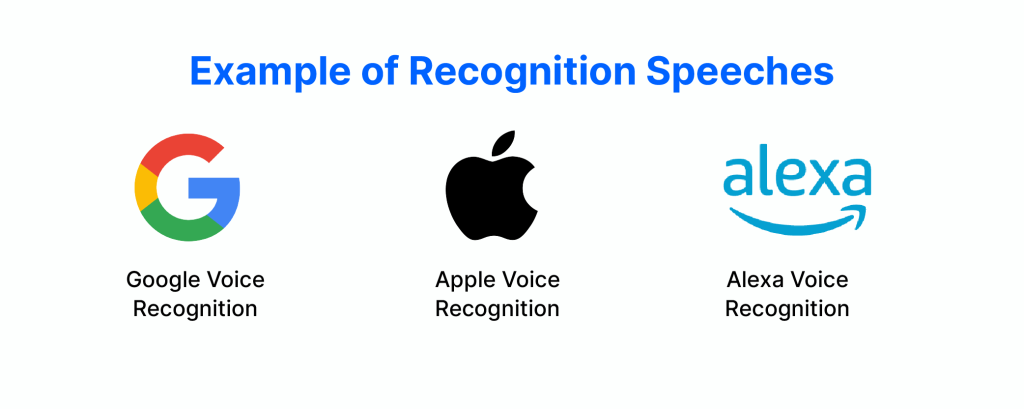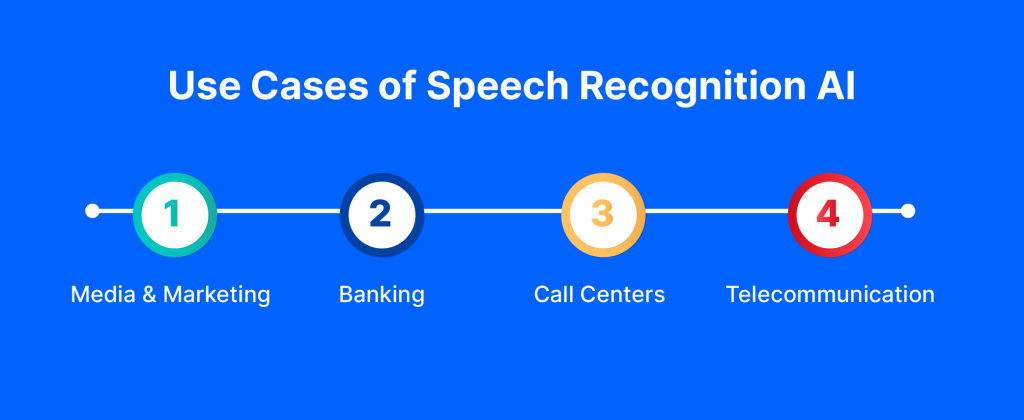When teams operate independently, it creates communication gaps that can lead to disorder. In contrast, when teams collaborate, they tend to be more efficient.
Speech recognition software can recognize and identify a single speaker from speech. Similar to fingerprints, each person has distinct characteristics in their voice that may be recognized by technology. This technique is already being used by numerous businesses to verify that a speaker is, in fact, the person they say they are.
Speech recognition just recognizes the words a person says; voice recognition does more. Rather, innumerable patterns and components that differentiate a person’s voice from another are analyzed by voice recognition software. AI Voice recognition is being used in both personal and professional spheres of life. Not everyone is aware of the function that voice recognition software performs. This is a brief overview of voice recognition technology, its operation, and several ways we’ve already used it.AI speech recognition is a technology that makes it possible for apps and computers to comprehend audio recordings made by people. Although it has been there for decades, the feature’s accuracy and sophistication have recently risen.
Speech recognition software and applications allow computers to understand human speech and convert it to text for business purposes. The speech recognition model operates by analyzing your speech and language using artificial intelligence (AI). It then learns the words you speak and outputs them as text data or model content on a screen with accurate transcription.
Artificial intelligence (AI) is the means by which AI voice recognition algorithms distinguish between different voices. Artificial intelligence voice recognition software needs to be trained with a human voice in order to accomplish this identification. The device makes the user read a passage aloud several times in order to record their unique speech patterns. The statement and the unique characteristics of the speaker’s tone, cadence, and other identifying cues are then examined by the AI. That person’s voice can then be recognized by the AI using a procedure known as “template matching.” When it comes to distinguishing between different speakers, voice recognition is quite accurate. That’s why developers have come up with a lot of uses for this technology. Speech recognition AI employs sophisticated algorithms to transcribe spoken language into text or commands. Here’s how it works:

Speech recognition begins with capturing audio input through a microphone or other audio recording devices. The audio signal is then digitized for processing.
The raw audio signal undergoes preprocessing to enhance clarity and remove noise. Techniques like noise reduction and signal normalization help improve the quality of the input.
Language modeling assigns probabilities to sequences of words or phrases based on their likelihood of occurring in a given context. This helps the system recognize and correct errors by considering the most probable word sequences.
During decoding, the system matches the acoustic features of the input speech against the acoustic and language models to determine the most likely sequence of words or commands. This process involves complex algorithms like Hidden Markov Models (HMMs) or deep neural networks.
Finally, the recognized text or commands are generated as the output of the speech recognition system. This output can be further processed for various applications, such as virtual assistants, dictation software, or voice-controlled devices.
Voice recognition products are becoming more and more commonplace. For instance, you can program your gadgets to start operating even before you arrive home with Google’s smart home kit. You can effortlessly and remotely monitor your spaces, lock your door, turn on the lights and heat, and more. Speech recognition, coupled with computer vision algorithms, forms a powerful combination, enabling systems to understand both spoken commands and visual cues for seamless interaction.
Your word choice is identified by speech recognition. You can turn on a smart TV without pressing a button and search for videos on YouTube without typing. By ensuring that only your voice can open your house, AI voice recognition goes one step further. You may depend on the technology to identify your unique voice in order to protect you.

Users can program their Android phones or tablets to recognize their voice using Google Voice Recognition. Users can train their gadgets to recognize their voice and commands by using “Voice Match.” With the help of this technology, users may activate navigation, chat with friends and family, and adjust settings on their phone while holding hands-free.
Similar to Google, users can teach their phones and tablets to recognize their speech. You may toggle the “Listen” feature for Siri on and off by going to “settings” on an iPhone or iPad, then selecting “Siri and Search.” When the “Set Up” screen for “Hey Siri” appears, it will ask you to speak so that the gadget can identify your voice.
You may also customize your devices to react to your voice commands using Amazon. You may set your device to recognize you by using Alexa Voice ID, often known as AI voice recognition. Because of this, Alexa is able to provide each user with individualized responses, recommendations, and updates.
Speech recognition AI is being utilized in a wide range of sectors and applications as a commercial solution. In the realm of speech recognition, integrating gesture recognition capabilities expands the scope of interaction, allowing users to communicate through both spoken words and hand movements. AI is making it easier for people to connect with software and technology more intuitively and accurately than ever before. Here are some examples.

One of the most common applications of voice AI in call centers is speech recognition. With the use of cloud models and this technology, you can listen to what customers have to say and then react accordingly.
Speech recognition technology can also be used for voice or audio biometrics, which is the use of speech patterns as identification or authorization proof for accessing systems or services, in place of passwords or other conventional models or methods like fingerprint or eye scans. Your voice, which is more secure, can take the place of company problems like lost passwords or hacked security codes!
Speech AI applications are being used by banking and financial institutions to assist customers with their business concerns. To find out the current interest rate on your savings account or your account balance, for instance, you can ask a bank. This results in faster response times and improved customer service since it reduces the amount of time customer support agents need to investigate and review cloud data in order to respond to inquiries.
Voice-activated Artificial Intelligence is becoming more and more popular in the telecom sector. Models for speech recognition technology allow for more effective analysis and management of calls. In order to provide better customer service, this enables agents to concentrate on their highest-value duties.
Consumers today feel more connected to businesses and have a better overall experience since they can communicate with them in real-time, around-the-clock, using text messaging apps or voice transcription services.
Speech recognition and AI are used by tools like dictation software to enable users’ type or write more in a lot less time. In less than thirty minutes, copywriters and content writers may typically transcribe up to 3,000–4,000 words.
However, accuracy has a role. 100% error-free transcription is not guaranteed by these techniques. Nevertheless, they are quite helpful in assisting those in the media and marketing to write their initial manuscripts.
Working with voice AI presents a number of difficulties. For instance, technology and the cloud are both relatively new and evolving quickly. Because of this, it is difficult to estimate with any degree of accuracy how long a company will need to develop its speech-enabled product.
Obtaining the appropriate tools for data analysis presents another difficulty when using voice AI. It could take some time and effort to obtain the ideal tool for your needs because the majority of individuals demand access to this technology or the cloud.
One of the primary hurdles in working with speech recognition AI is the variability of human speech. Accents, dialects, and pronunciation differences pose challenges for algorithms trained on standardized speech data. Adapting speech recognition systems to accurately interpret diverse linguistic patterns remains an ongoing endeavor. In the realm of speech recognition, AI plays a pivotal role in decision-making processes, enabling systems to analyze and interpret spoken language to make informed decisions autonomously.
Moreover, the variability in speech patterns within individuals adds complexity to speech recognition tasks. Factors such as speech rate, volume, and enunciation vary from person to person and even within the same individual across different contexts. Developing AI systems capable of adapting to these variations and maintaining accuracy is a formidable task.
Privacy concerns also loom large in the realm of speech recognition AI. As these systems capture and process audio data, there are legitimate concerns about data security and privacy breaches. Ensuring robust data protection measures and transparent privacy policies is essential to earning user trust and compliance with regulatory standards.
Choosing IntellicoWorks for your AI development services ensures access to a team of seasoned experts with extensive experience in crafting cutting-edge solutions. We prioritize innovation, constantly staying updated with the latest advancements in AI technology to deliver state-of-the-art solutions tailored to your specific requirements. Our collaborative approach ensures open communication and transparency throughout the development process, ensuring that your vision is realized to its fullest potential. Additionally, we are committed to delivering solutions that not only meet but exceed expectations, evidenced by our track record of successful implementations and satisfied clients. With IntellicoWorks, you can trust in our dedication to quality, excellence, and ongoing support, ensuring that your AI projects achieve success and drive tangible business value.
AI voice detector technology has revolutionized human-machine interaction, making it more intuitive, convenient, and accessible. By leveraging advanced algorithms and machine learning techniques, voice recognition systems continue to evolve, offering new possibilities for communication and interaction in the digital age.
Voice recognition AI systems utilize advanced algorithms to interpret spoken language and execute commands or perform tasks based on user input. Speech recognition in artificial intelligence involves the analysis of audio signals to transcribe spoken words into text or trigger actions in various applications.
Discover the Future of Technology with Our AI Development Services!

Talk to us and let’s build something great together
A Subsidiary of Vaival Technologies, LLC
IntelliCoworks is a leading DevOps, SecOps and DataOps service provider and specializes in delivering tailored solutions using the latest technologies to serve various industries. Our DevOps engineers help companies with the endless process of securing both data and operations.
Ops
Cloud
AI & ML
Copyrights © 2023 byIntellicoworks. All rights reserved.